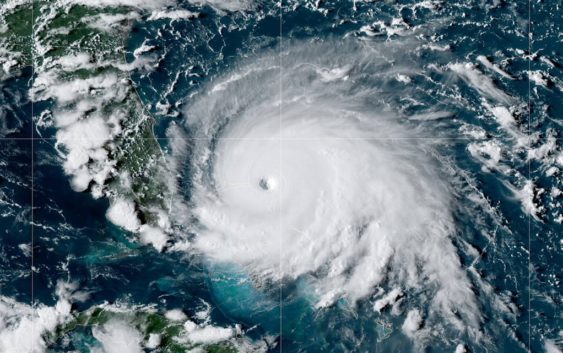- South Carolina's governor declares State of Emergency as massive wildfire grows to 1,600 acres
- Staying weather alert: How to find your safe place during severe weather
- Wildfires persist across Carolinas amid windy, dry conditions
- York County crews help battle South Carolina wildfires
- Crews battle wildfires in North and South Carolina amid dry conditions and gusty winds
Hurricane Dorian declared a powerful Category 5

CHARLOTTE, N.C. — Here’s the latest on Hurricane Dorian
As of the 5 p.m. et update from the National Hurricane Center
LOCATION: ABOUT 95 MILES EAST OF FREEPORT GRAND BAHAMA ISLAND, ABOUT 175 MILES EAST OF WEST PALM BEACH FLORIDA
MAXIMUM SUSTAINED WINDS: 185 MPH
MOVEMENT: W AT 5 MPH
On Sunday, the National Hurricane Center declared Hurricane Dorian as a Category 5 hurricane. This is a powerful and dangerous catastrophic storm.
The eye of Hurricane Dorian, which is described as a catastrophic hurricane, is crawling over the Abacos Islands in the Bahamas.
The National Hurricane Center advised residents there to take immediate shelter. Maximum winds have increased to near 180 mph with gusts over 200 mph.
Dorian is moving toward the west near 5 miles per hour, according to the National Hurricane Center. Slower westward to west-northwestward motions are expected to continue for a day or two, followed by a gradual turn toward the northwest.
Currently, the core is expected to continue to pound Great Abaco Sunday evening and move near or over Grand Bahama Island Sunday night and Monday.
The hurricane is expected to move dangerously close to the Florida east coast late Monday through Tuesday night, according to the National Hurricane Center.
There is an increasing likelihood of strong winds and dangerous storm surge along the Carolina coasts as well as the Georgia coast later in the week.
North Carolina issued a state of emergency ahead of potential impacts from Hurricane Dorian. South Carolina Governor Henry McMaster also declared a state of emergency because of the threat of Hurricane Dorian.
Later on Saturday, the city of Charleston declared a state of emergency as well, to ensure the city is fully prepared for emergency operations. The Municipal Emergency Operations Center will be activated Sunday at 8 a.m. and will remain open as needed throughout the storm.
According to the National Weather Service, there is an increasing risk of strong winds and dangerous storm surge along the coasts of Georgia, South Carolina and North Carolina during the middle of the week.
It looks like Dorian will ride off the Florida coast and turn up along the South Carolina coast by late Wednesday into Thursday as a Category 3 hurricane, according to the National Hurricane Center.
The storm is moving west at 5 mph. It is 295 miles east of West Palm Beach, Florida.
While some fluctuations in intensity are completely likely, Dorian is expected to stay a powerful hurricane over the next few days, according to the NHC.
A Hurricane Warning is in effect for Northwestern Bahamas excluding Andros Island, as well as from Jupiter Inlet to the Volusia/Brevard County Line.
A Hurricane Watch is in effect for Volusia/Brevard County Line to the Flagler/Volusia County Line, North of Deerfield Beach to Jupiter Inlet, and Andros Island.
A Tropical Storm Warning is in effect for North of Deerfield Beach to Jupiter Inlet, and a Tropical Storm Watch is in effect for North of Golden Beach to Deerfield Beach and Lake Okeechobee.
A Storm Surge Warning was issued from Lantana to the Volusia/Brevard County Line, and a Storm Surge Watch was issued from the Volusia/Brevard County Line to the Flagler/Volusia County Line, as well as from North of Deerfield Beach to Lantana.
On this track, the core of Dorian should move over the Atlantic well north of the southeastern and central Bahamas Friday night and Saturday, be near or over the northwestern Bahamas on Sunday, and be near the Florida east coast late Monday.
The core of Dorian is expected to be near or over part of the northwestern Bahamas on Sunday, then move closer to the Florida east coast late Monday through Tuesday.
Swells are likely to begin affecting the east-facing shores of the Bahamas, the Florida east coast, and the southeastern United States coast during the next few days. These swells are likely to cause life-threatening surf and rip current conditions.
Flooding will be a major concern for Florida. Rainfall rates, combined with storm surge, could result in life-threatening flash floods.
It is still not known exactly where the storm will make landfall but forecasts believe it will likely be in Florida. The uncertainty, which is commonly portrayed in the forecast track’s “cone of uncertainty,” will shrink as the storm moves closer to shore.
RELATED: 5 Things to Know About Hurricane Dorian
Panovich said everyone living along the Southeast coast should be paying attention. The track could shift.
“Residents in these areas should ensure that they have their hurricane plan in place and not focus on the exact forecast track of Dorian’s center,” according to the National Hurricane Center.
Regardless of where the storm ultimately makes landfall, heavy rain can be expected in across the Southeast next week, including in portions of North Carolina, South Carolina, Georgia, and Florida.
RELATED: Airlines offer travel waivers as Dorian reaches hurricane strength
RELATED: Person struck by lightning in Marion, numerous tress toppled during storms
RELATED: Lightning strikes kill 5, injure over 100 in eastern Europe’s Tatra Mountains
RELATED: Extensive tree damage in Statesville after severe weather
RELATED: Two rescued from flooded car during Charlotte storms